
Beginning in late July till the first week of August we were in Mali for deploying, testing and gathering feedback for the Foroba Blon project, where we deployed the first prototype of the radio platform. We tested the application with citizen journalists and rural radio stations and gathered feedback to continue developing and customizing the platform.
It also provided us with a valuable opportunity to interact with the radio stations to better understand the uptake of Radio Marche services and gather feedback from producers as well as buyers currently using the platform. We will continue to monitor and enhance this service and will share our experiences on the Radio Marche platform in a separate post.
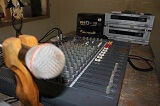
Prior to our departure Max summarized Foroba Blon and our Radio Platform for Citizen Journalists in an excellent post, that may have given you some context of what we were testing during this trip. As stated before it is a tool for community radios to gather news submitted by mobile phones. In its deployed state the platform is accessed by calling a local phone number and interacting with an IVR menu. As part of the citizen’s interface the community correspondents can call the system and leave stories, local news, opinion linked to programs broadcast by rural radio stations, or any other piece of information they want to share with radio listeners.
These voice messages are captured and stored on the platform. Subsequently the radio stations can call the system, manage the messages and broadcast the same after due processing and as per the editorial practises of the radio stations.
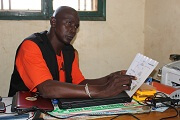
We started our campaign with a quick introductory first stop at Radio Sikidolo (translates into radio North Star). It presented an interesting case because it has a dedicated base of citizen journalists already engaged in collecting information and news items to be broadcast over the radio. The communiques and associated services like announcements etc. are paid for by people in remote villages and intermediaries collect these along with aggregated payments for the radio to broadcast. Foroba Blon services provide them the opportunity to cut down on this time lag and manual processing of news feeds.
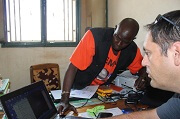 As Sikidolo has its own way on engaging and training their pool of citizen reporters, we are currently engaged in discussions with them and estimating their initial training needs for a full scale deployment. It was heartening to note that this requirement came from the radio itself on one simple demonstration, strengthening our long held view that this was indeed a service that would not only benefit the community but also encourage community radios to adopt and deploy voice based services.
As Sikidolo has its own way on engaging and training their pool of citizen reporters, we are currently engaged in discussions with them and estimating their initial training needs for a full scale deployment. It was heartening to note that this requirement came from the radio itself on one simple demonstration, strengthening our long held view that this was indeed a service that would not only benefit the community but also encourage community radios to adopt and deploy voice based services.
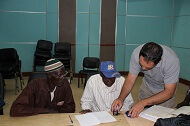
Our next stop was Radio ORTM Segou. We have been collaborating with ORTM Segou for the Radio Marche project and hence it was easy to test the waters linked to our new citizen journalism application (you can play with a demo here) with Fousseyni Diarra. Stephane gave a demo of the voice based application to 3 citizen journalists linked with Radio Segou – Adam Coulibaly, Siaka Adama-Massala and Karim Coulibaly.
Initially all of them took few re-runs of the menu prompts to fully absorb the system, but once they were able to understand the call flow it was easy for them to subsequently use the system. Their initial difficulty in navigating the slightly complex menu gave us a novel idea- to develop a small colour coded menu card in Bomu and Bambara that would allow them to intuitively understand the various menu prompts and the linked services. The citizen reporters were very happy at the prospect of being able to listen in on voice feeds provided by their colleagues from other villages

We quickly developed this card and used it extensively for all our subsequent demonstrations with other rural radio stations, (including a follow up trip to Radio Sikidolo).
Our next stop was an all-day demonstration and feedback meeting with Radio Moutian and a group of 5 citizen journalists associated with the radio. Much like Radio Segou and Sikidolo it was easy for the citizen reporters to understand the flow of the application now aided by the colour coded flowchart.
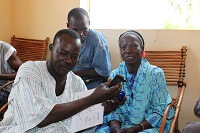
They gave insights on what sort of information was in demand by the villagers – e.g. interest in collecting rainfall data, posing questions to local politicians over radio, a range of personal announcements like searching for lost cattle, health related questions etc. Radio Moutian also has a topic based call in program every Monday and Thursday where Foroba Blon applications finds a natural fit.
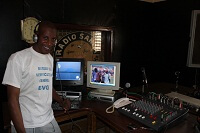
We now proceeded to Radio Saniya, a relatively small and family run rural radio in Tominian. It catered to relatively well to do villages in terms of outreach and had relatively new and better radio broadcast equipment. Radio Saniya has a membership scheme that generates additional revenue for sustainability. This membership enables card holders to a defined number of communiques. The Foroba Blon application again was easily understood by the radio staff and they requested us to meet the director to bootstrap the deployment process instantly, which was quite encouraging.

We came across an interesting use case during our discussions that stands out as a utility for future development. Most of the development NGO’s send audio tapes linked to their areas of work e.g. education, health, livelihoods etc. to these rural radio stations for broadcast. As there is no central voice based syndication service these tapes travel from region to region by hand for broadcast. Not only is this an expensive process, it also takes up lot of time thereby adversely impacting the intended use and delivery of important information. In subsequent iterations of this project we are contemplating including this use case for the rural radio stations.
Another remarkable finding of the field trip was the availability of mobile internet access by Orange and Malitel. The usb data access keys are readily available across most radio stations now and we realized the importance of providing individual web interfaces to the rural radios. The first version of radio specific website is now up and we are in the phase of encouraging its use by the stations. As of now due to the non availability of data services, only radio Seno in Bankass has to access the content via the voice interface. In total we are now engaged with 4 rural radio stations and a very enthusiastic blogger Boukary Konate.
Apart from the technology which was accepted by an overwhelming majority we are now also focusing our attention to more important aspects of sustainability and viability. It has to be a right mix of services that are not only needed by the rural  citizens but also something that makes existing process flow of citizen generated content easy to process by the rural radios. Training and capacity building of rural reporters is a key piece of this strategy. The next steps for us are finalizing the technology interface based on all the feedback we collected, identify the key constituents of a sustainable business model, create sufficient excitement amongst the diaspora to enrich the services at this nascent stage and carry on organizing and convening radio group meetings to propagate the benefits of Foroba Blon across community radio stations.
citizens but also something that makes existing process flow of citizen generated content easy to process by the rural radios. Training and capacity building of rural reporters is a key piece of this strategy. The next steps for us are finalizing the technology interface based on all the feedback we collected, identify the key constituents of a sustainable business model, create sufficient excitement amongst the diaspora to enrich the services at this nascent stage and carry on organizing and convening radio group meetings to propagate the benefits of Foroba Blon across community radio stations.
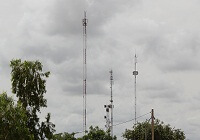
Anna Bon
August 31, 2012
Nice blogpost. Good to know that Foroba Blon is getting really well accepted!
Reply